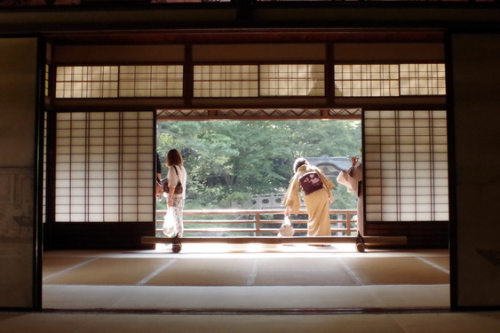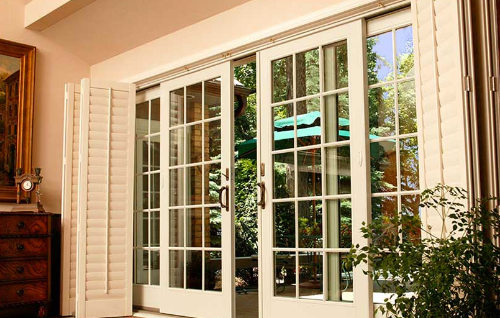Patio Doors
Patio doors allow you to access your backyard space easily. Many of them have large panes of glass providing not only a great of your backyard, but also bring in lots of natural day light. Sliding glass doors have historically been the most popular, but modern trends have leaned toward french style patio doors as they look new and fresh. The room the the patio doors is in is usually a dining or family room. Taking this into consideration, a sliding door in this location makes a lot of sense for being able to not have a swinging door that might bump into tables or chairs that you may want right next to the patio door.
 Sliding glass doors first become popular early 1900's when designers brought back the design from Japan where they had a door called a shoji. This is a translucent sliding door with a wooden frame that slides open and closed on rollers.The Japanese shoji door is the country's distinctive trademarks and is full of culture and history.
Sliding glass doors first become popular early 1900's when designers brought back the design from Japan where they had a door called a shoji. This is a translucent sliding door with a wooden frame that slides open and closed on rollers.The Japanese shoji door is the country's distinctive trademarks and is full of culture and history.
There are many different styles and sizes of glass framed sliding patio doors available now. Many of the larger ones really standout and add a dramatic look to your home. They also add a fantastic view as well.
French Patio Doors
As previously noted, French patio doors are gaining popularity as a substitute for sliding glass doors when used as an entrance to an outdoor patio. The origin of the French patio door dates back to the 1700s in France, particularly during a time of war when electricity was scarce. People had to depend on natural light due to the limited availability of alternative lighting sources such as candles and lamps.
 French doors are designed to be like a hinged windows bringing in lots of natural light while allowing people to open them for good air flow in the summer and more light during the winter months. They are very popular in Europe now days as people know its right history coming from the Italian Renaissance architecture influence. In fact, its design style comes more from Roman architecture than it does from French. The first doors were made with wood frames or even iron. It has only be recently that companies have made them with vinyl or aluminum. When the switch over to aluminum frames came, people didn't realize how much heat would be lost through the cold metal frame until vinyl frames which were being used on windows came about and companies started to use vinyl for French doors as well to save energy. Now we have options like steel covered wood, vinyl, and fiberglass.
French doors are designed to be like a hinged windows bringing in lots of natural light while allowing people to open them for good air flow in the summer and more light during the winter months. They are very popular in Europe now days as people know its right history coming from the Italian Renaissance architecture influence. In fact, its design style comes more from Roman architecture than it does from French. The first doors were made with wood frames or even iron. It has only be recently that companies have made them with vinyl or aluminum. When the switch over to aluminum frames came, people didn't realize how much heat would be lost through the cold metal frame until vinyl frames which were being used on windows came about and companies started to use vinyl for French doors as well to save energy. Now we have options like steel covered wood, vinyl, and fiberglass.
Sliding Patio Doors
Sliding doors have been used for a long time even in ancient history as far back as the first century AD. Archaeologists have found their use in ancient Roman ruins. Sliding glass doors became very common in homes during the 20th century, especially during the pre-war era and especially after World War II when they became increasingly popular in homes most likely because of people's exposure to Japanese culture and their doors called shoji, which is a sliding translucent door with a wooden frame.
 There are two types of sliding doors in use today. First one is a bottom roller type and the other is a top hung type. The bottom rolling sliding doors are used when top hung doors cannot be used because of the weight of the door. Generally they have two rollers called sheaves and sit on tracks with two guides on the top running in a guided track channel. The weight of the door is supported by the two wheels on the bottom. It can be more difficult to open and close a sliding door that has bottom rollers as the track can become dirty and the wheels can wear more easily. The rollers and develop flat side on them causing them to slide rather than roll over years of use. Greasing the track makes the issue worse.
There are two types of sliding doors in use today. First one is a bottom roller type and the other is a top hung type. The bottom rolling sliding doors are used when top hung doors cannot be used because of the weight of the door. Generally they have two rollers called sheaves and sit on tracks with two guides on the top running in a guided track channel. The weight of the door is supported by the two wheels on the bottom. It can be more difficult to open and close a sliding door that has bottom rollers as the track can become dirty and the wheels can wear more easily. The rollers and develop flat side on them causing them to slide rather than roll over years of use. Greasing the track makes the issue worse.
Top hung sliding doors are more common than bottom roller sliding doors. With this type, the sliding door is supported by two trolley hangers that run along a track that is usually hidden from sight. There is a track stopper on either end to stop the sliding door as it runs along the track and closes fully or opens fully. The stopper on the opening side keeps fingers from getting smashed between the door frames.
Patio Screen Doors
Screen doors developed during the 1800's when mass production of wire and thus screens came on to the scene in America. Technology to produce large quantities of wooden frames also helped the adoption of screen doors. Screens for windows and doors first were invented by a company named Gilbert, Bennett, and Company. In 1861 they were making a mesh sieve for sifting flour made of wire. The company got the idea they could make larger screens and use them to keep the bugs our when windows were opened. Several years later, they were able to make the screens even larger allowing for screen doors to be made allowing people to leave their regular doors open while keeping the insects out with the screen door.
 Screen doors endure constant movement and wear, making durable construction essential. Many feature pegged, mortise-and-tenon joints and hardwood frames for stability and rot resistance. Traditionally, clear-finished or painted wood is used for a classic look. Historically, bronze screens were preferred for their longevity, outlasting materials like galvanized steel. Aluminum screens, introduced later, became a more affordable and durable alternative. In recent years, fiberglass screens have gained popularity for their lightweight design, improved visibility, and affordability—making replacements easy and cost-effective when damaged.
Screen doors endure constant movement and wear, making durable construction essential. Many feature pegged, mortise-and-tenon joints and hardwood frames for stability and rot resistance. Traditionally, clear-finished or painted wood is used for a classic look. Historically, bronze screens were preferred for their longevity, outlasting materials like galvanized steel. Aluminum screens, introduced later, became a more affordable and durable alternative. In recent years, fiberglass screens have gained popularity for their lightweight design, improved visibility, and affordability—making replacements easy and cost-effective when damaged.
There are many different design styles of patio screen doors, like Traditional, Chalet, Anglo-Japanese, Colonial Revival, Bungalow, Late Victorian, Southwest, and Prairie.
Patio screen doors are usually pared with a sliding glass door allowing the glass door to be opened and the sliding screen door to be pulled closed. This gives great air flow and because patios with plants, grass, and trees near by tend to be cooler than paved areas because of evaporation, cooler air can come in. This was especially important before air conditioning units and central air were available or affordable for most people. Now patio screen doors are much less popular with A/C performing much better.
